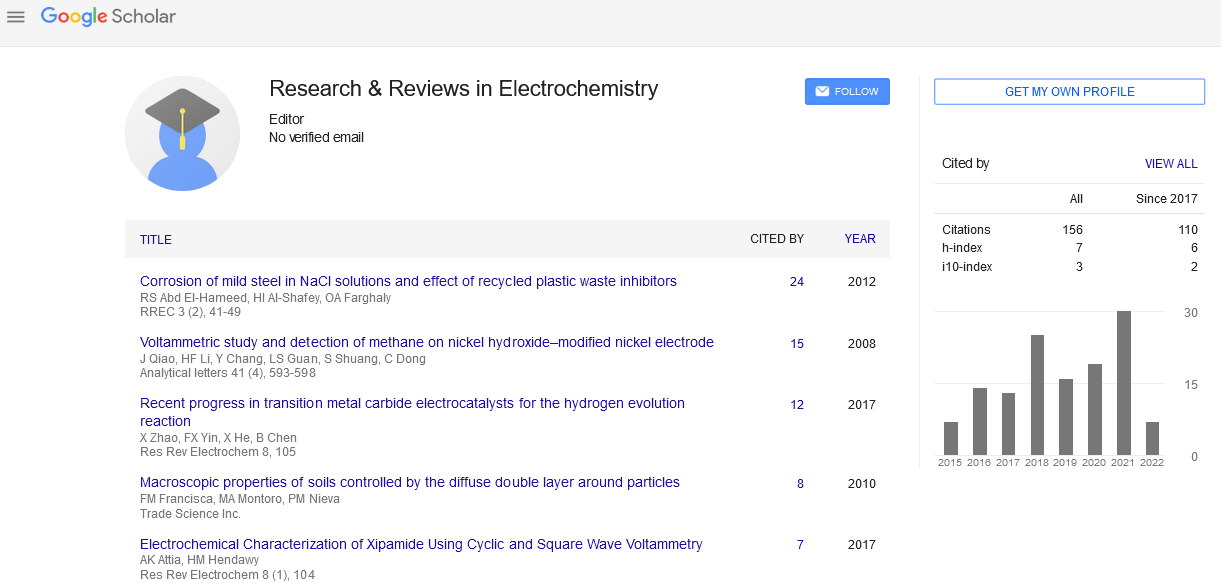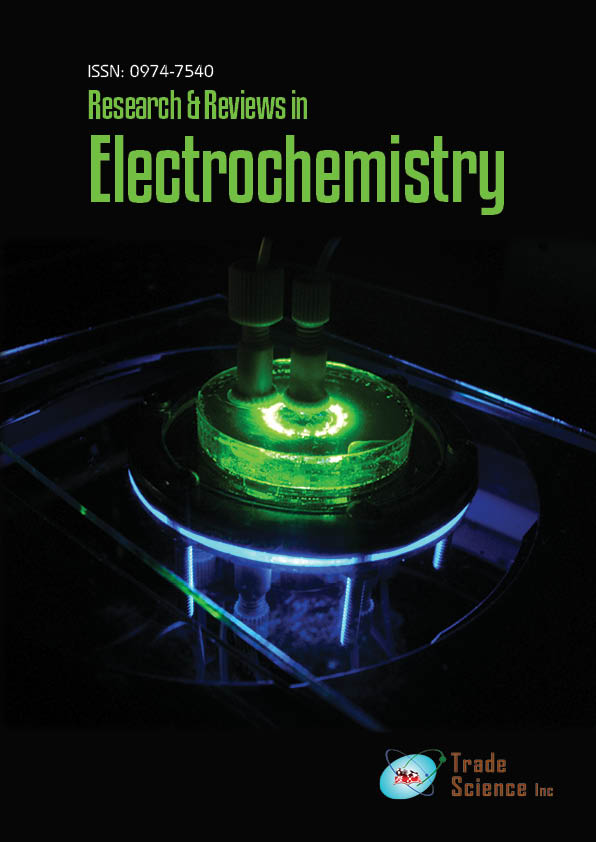Short commentary
, Volume: 12( 4) DOI: 10.37532/0974- 7540.22.12.4.249Asymmetric Activated Carbon/Activated Carbon Capacitors Design
- *Correspondence:
- Gary Lu
Editorial Office, Research and Reviews in Electrochemistry, UK
E-mail:electro.med@scholarres.org
Received: 4-July-2022; Manuscript No. tsrre-22-72682; Editor Assigned: 18-July-2022; PreQC No. tsrre-22-72682 (PQ); Reviewed: 23-July2022; QC No. tsrre-22-72682 (Q); Revised: 28-July-2022; Manuscript No. tsrre-22-72682 (R); Published: 30-July-2022, doi no. 10.37532/0974- 7540.22.12.4.249
Citation:Charles G. Materials Considerations for Flexible Supercapacitors. Res Rev Electrochem 2022;12(4):248.
Abstract
Supercapacitors are energy storage devices that, when compared to batteries, has a high power density but a low energy density. Their low energy density can be overcome by employing an asymmetric configuration in mass electrodes, in which each electrode operates within its maximum available potential window, resulting in the system's maximum voltage output. The capacitance and potential stability limits of the electrodes are used to optimize such asymmetric capacitors, with the design's reliability largely dependent on the accuracy and approach used for electrochemical characterization. As a result, if a well-thought-out procedure is not followed, performance may be lower than expected, and the system may fail.
Introduction
The electrostatic interaction that occurs between the polarized surface of the porous carbon electrode and the ions of the electrolyte that forms the electric double layer is responsible for the energy storage mechanism in supercapacitors. This storage mechanism responds faster to changes in the potential applied to the electrodes (i.e., charge/discharge of the devices) than batteries and fuel cells. As a result, supercapacitors can be charged in a matter of minutes, have superior power characteristics to conventional secondary batteries and fuel cells, and have a longer lifetime. Based on the foregoing, supercapacitors can be used to deliver a high power demand in a short period of time, without causing damage to the power train system, when hybrid-electric and fuel cell vehicles accelerate, and to recover energy when they brake. The main barrier to widespread commercialization is their low energy density, which is determined by the capacitance of the electrodes and the cell's voltage. To increase the number of applications where supercapacitors could be used, either the capacitance of the materials used as electrodes or the working voltage of the device must be increased. As a result, there is a large number of works that aim to increase the capacitance and potential window of electrodes and solvent.
The capacitance of an electrode is proportional to the surface area available for the formation of the charged double layer and inversely proportional to the distance between the ion and the electrode's polarized surface. The wettability of the porosity of the electrode is related to the available surface area, which results from the combination of, on the one hand, the polarity and size of the molecules of the solvent and the ions that comprise the electrolyte, and, on the other hand, the pore size and surface chemistry of the electrode. To avoid ion sieving effects and to improve surface capacitance, the pores of the electrode must be similar in size to the ions of the electrolyte. Additionally, a surface chemistry of the electrode that matches that of the solvent will aid in delivering a high wettability of the porosity's surface. Furthermore, faradaic reactions involving the surface groups of the electrodes can contribute to capacitance via the "pseudo capacitance" contribution. This contribution can boost the capacitance of certain advanced carbon materials, and while it is most commonly found in aqueous-based electrolytes, it can also boost the capacitance of organicbased electrolytes. Porous carbon materials are the best suited materials for achieving high capacitance because they combine high electrical conductivity, chemical and physical stability, and a tunable pore structure and surface chemistry, allowing electrodes to be prepared with tailored properties to maximize the resulting capacitance.
The working voltage of supercapacitors is primarily determined by the solvent used in the electrolyte formulation. The most commonly used electrolytes have tolerable working voltages of around 1 V for aqueous-based electrolytes, 2.5-2.7 V for organicbased electrolytes, and more than 4.0 V for ionic liquids electrolytes. Organic-based electrolytes are used in the majority of commercial devices due to their high cell voltage and higher specific energy than aqueous systems. Nonetheless, organic-based systems have a lower specific power than water-based electrolyte supercapacitors, and aqueous systems would be preferable for economic, toxicity, and environmental reasons. It is worth noting that the surface chemistry of carbon materials can be tuned to provide an over potential for solvent decomposition, which has been used to achieve larger operating voltage windows in aqueous media. This effect is especially noticeable in neutral media, allowing for voltages of 2.0 V, making this environmentally friendly, safe, and cost-effective electrolyte viable.
Aside from materials and electrolytes, there are design strategies that can improve supercapacitor energy density, such as hybrid and asymmetric configurations. The hybrid designs enable the use of both pseudo capacitive and capacitive electrodes in the same device. This combination takes advantage of the high capacitances of pseudo capacitive materials while increasing the operational voltage window and cell capacitance through the careful selection of a porous carbon material that serves as the electrode where the pseudo capacitive material has no redox contribution and low stability. This configuration has been used to create Li-ion capacitors that combine an activated carbon electrode with graphite or crystalline intercalation compounds. Wide voltage can also be achieved in water-based electrolytes capacitors by combining an activated carbon electrode with an electrode made of transition metal oxides and conducting polymers supported over a carbon material in the same cell. The asymmetric configuration, on the other hand, can consist of either combining two different porous carbon materials in one device or using the same porous carbon material in both electrodes but with different electrode weights. The operating voltage of acid-based supercapacitors can be increased to 1.6 V using activated carbons with optimized surface chemistry for each electrode in the first case, while those prepared in neutral aqueous electrolytes can reach outstanding voltage values as high as 2.0 V. Finally, a cell design based on mass asymmetry of electrodes made of the same material is the most cost-effective and labor-intensive approach to increasing supercapacitor energy density. It only requires the use of two different weights for each electrode, making it simple to implement in both laboratory and commercial supercapacitor preparation. This method consists of three steps:
(i) performing electrochemical characterization of the porous carbon material on the potential windows where it will work as a positive or negative electrode in the capacitor, (ii) determining both the gravimetric capacitance and the electrochemical stability window for each electrode and (iii) adjusting the weight ratio of the positive and negative electrodes to take full advantage of the available electrochemical stability windows. This strategy has been used successfully in a variety of scenarios, including hybrid capacitors, asymmetric in material capacitors and asymmetric in mass capacitors.

